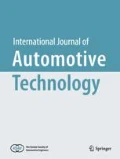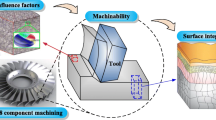Abstract
It is essential to develop efficient and cost-effective production methods to achieve or maintain international competitiveness. An innovative production method, such as rotary blanking, enables manufacturers to both reduce expenses and economize production time. However, there are not enough numerical analyses for this process. In this paper, numerical simulations of rotary blanking were performed. After comparing the cutting planes generated by conventional and rotary blanking experimental tests, the cutting areas of two punch geometries were analyzed. The influence of punch geometry on part quality was then investigated through simulations. The procedure for die stress analysis was established and stress distributions of the worksheet and the tools were analyzed.
Similar content being viewed by others
Abbreviations
- \( \overline \varepsilon \) :
-
effective strain
- \( \overline \varepsilon _0 \) :
-
initial effective strain
- \( \overline \varepsilon _f \) :
-
fracture effective strain
- σ * :
-
max. principle tensile stress (MPa)
- \( \overline \sigma \) :
-
effective stress (MPa)
- C 0 :
-
critical damage value
- E :
-
young’s modulus (GPa)
- K :
-
strength coefficient (MPa)
- n :
-
strain hardening exponent
- v :
-
poisson’s ratio
References
Blumauer, G. (1975). Darstellung der bewegungsverhaeltnisse an der wirkstelle eines rotationsbearbeitungsverfahrens. Die Technik, 30, 462–466.
Cockroft, M. G. and Latham, D. J. (1968). Ductility and workability of materials. J. Inst. Met., 96, 33–39.
Edelstahlwerke Buderus AG (1997). Cold Forming and Fineblanking. Feintool AG Lvss, Wetzlar, 141–153.
Hoffmann, H. and Schweitzer, M. (1999). Rotary Blanking. Annals of the CIRP 48,1, 213–216.
Hoffmann, H., Hein, C. and Hong, S. (2007). Rotary blanking: tool materials. Annals of the German Academic Society for Production Engineering 1,3, 259–264.
Kalpakjian, S. (1999). Manufacturing Processes of Engineering Materials. 3rd edn. Pearson Education. Korea.
Kim, H., Park, J. and Kim, H. (2004). A study on the effect of clearance and V-ring shape in a fine blanking process. J. Industrial Technology, Kangwon Natl. Univ. Korea 24 A, 29–35.
Lee, T. C., Chan, L. C. and Wu, B. J. (1995). Straining behaviour in blanking process — Fine blanking vs. Conventional blanking. J. Mater. Process. Technol., 48, 105–111.
Noak, M. (1982). Technologische Unterschungen zum Perforieren von Metallband Mittels Rotierender Werkzeuge. Technische Hochschule Otto von Guericke Magdeburg. Ph. Dissertation. Germany.
Oh, S., Chen, C. C. and Kobayashi, S. (1979). Ductile fracture in axisymmetric extrusion and drawing-Part 1. Trans. ASME. J. Engineering for Industry, 101, 23–35.
Schmidt, T. (2004). Verbesserung der Schnittflaeche durch Anpassung der Stempelgeometrie an die Kinematik des Rotationsschneidens. Technische Universitaet Muenchen. Ph. Dissertation. Germany.
Schweitzer, M. (2001). Prozessspezifische Merkmale des Rotationsschneidens. Technische Universitaet Muenchen, Ph. Dissertation. Germany.
Author information
Authors and Affiliations
Corresponding author
Rights and permissions
About this article
Cite this article
Hein, C., Hong, S., Suh, J. et al. Finite element analysis of rotary blanking: Effects of punch geometries on cutting area and stress distribution. Int.J Automot. Technol. 9, 211–216 (2008). https://doi.org/10.1007/s12239-008-0027-4
Received:
Revised:
Published:
Issue Date:
DOI: https://doi.org/10.1007/s12239-008-0027-4




